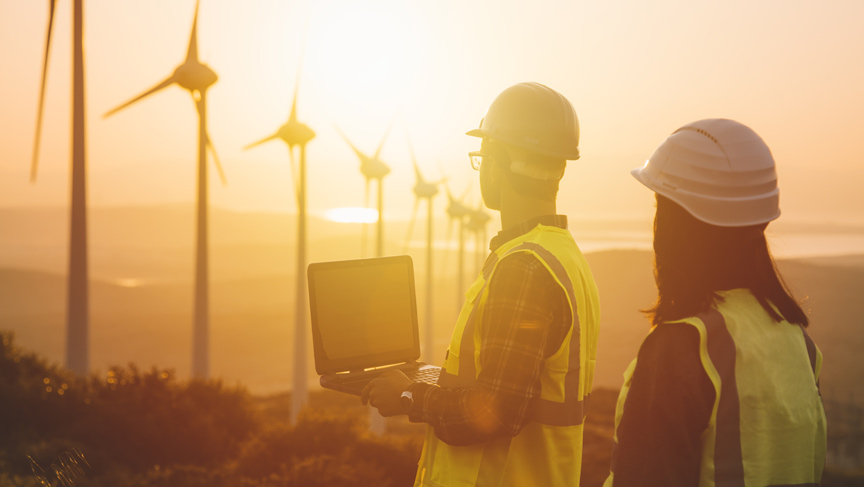Insight
Helping you achieve your sustainability ambitions

As the UK moves towards its greenhouse gas emission reduction target of carbon neutrality by 2050, carbon taxes and levies are set to increase.
Changes in the UK energy sector
Ahead of this, businesses and industries are making adjustments to steer towards a more sustainable use of energy. The combination of these targets and levies will change the way we generate, distribute and use electricity. In the UK, coal is in decline and renewable forms of generation are on the rise. Not only is the way that we generate power changing, but where generation connects to the electricity system is changing as well. The use of Distributed Energy Resources (DERs) including solar, wind, combined heat and power as well as battery storage, has been on the rise as more businesses are looking towards on-site generation for cost saving, resilience and sustainability reasons. This increase of DERs on the network means more electricity is being generated locally, closer to demand.
With increasing environmental standards, there is increased pressure on institutions, government agencies and businesses to meet sustainability goals. These organisations are seeking to find feasible ways to be more energy efficient while reducing their carbon footprint. Incorporating sustainable energy resources into an organisation’s daily operations is one of the solutions to help meet sustainability targets, lower operational costs, and provide greater independence from the threat of rising energy tariffs. The implementation of such solutions, that address the sustainability targets, will affect the way businesses operate. For instance, an increasing number of organisations are already electrifying their vehicle fleets in order to cut emissions and prepare for the future.
Greener and smarter microgrids
A microgrid is a local energy system that incorporates three key components: generation, storage and demand, all within a bounded and controlled network. When coupled with DERs, a microgrid can demonstrate an efficient and cost-effective way to integrate renewable energy resources into daily operations, turning the challenges of meeting your sustainability targets into cost savings and revenue generating opportunities. For example, a solar photovoltaic installation coupled with battery storage can support the organisation’s energy requirements while exporting excess energy to the grid at peak times to generate additional revenues.
Taking a step further, advanced microgrids can be programmed, using SCADA systems, which are control systems that manage supply, demand and generation, to achieve specific sustainability goals. Microgrids with SCADA systems can prioritise renewable energy sources and make use of energy storage to balance supply and demand when needed. Thus, microgrids can ensure a continuous and green power supply even when renewables aren’t producing.
We are helping organisations to unlock the potential of microgrid solutions. Recently we analysed different infrastructure requirements and technology options for one of the UK’s leading airports. The airport envisioned a growth strategy that would significantly increase the number of passenger journeys whilst maintaining its position as the premier gateway for business, leisure and travel. To realise these goals, the airport needed to better understand how their energy infrastructure and technology could be evolved to support additional capacity and deliver on their sustainability ambitions.
We carried our evaluation assessments across technologies including combined heat and power generation, solar PV generation, water-source heat pumps, electric energy storage, SCADA and thermal energy storage technologies. Our recommendations translated to identified projects to improve the airport’s network resilience and provide commercial and sustainability benefits. In addition, the proposed solution, a microgrid with combined heat and power and solar PV, will help the airport avoid 205 tonnes of carbon dioxide emissions per year, equivalent to planting 9,447 trees* , whilst also cutting its annual energy costs by 5%.
Virtual microgrids
Microgrids are not limited to one physical site or location. Organisations with multiple premises can also create a microgrid that virtually connects multiple sites across the country; this is known as a Virtual Private Wire Network (VPWN). This approach enables organisations to produce low carbon electricity at suitable locations while consuming this energy at multiple sites.
With all of these benefits, more businesses and institutions are moving towards managing their own networks by implementing microgrid solutions at their premises.
Microgrids could be the key to your sustainable business growth. We deliver microgrid solutions to our clients to achieve their strategic objectives, whilst providing them with opportunities to generate revenue, through our assured solutions and long-term expertise.
*A tree can absorb 21 kg of carbon dioxide per year.







